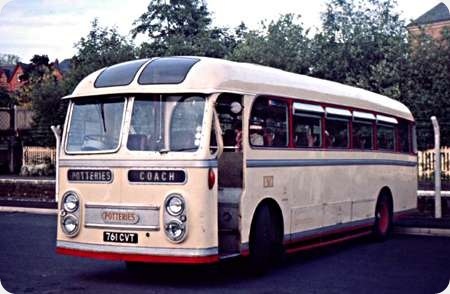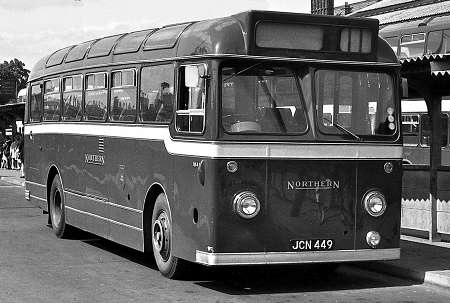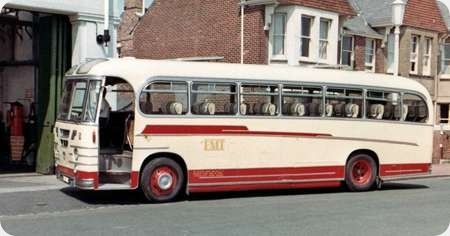
Potteries Motor Traction
1958
AEC Reliance 470
Willowbrook C41F
PMT had five of these coaches plus one similar acquisition on a Leyland Tiger Cub chassis from the takeover of Dawsons, Ash Bank. They suffered as always with AH470 engines with cylinder head gasket and wet liner seal failures. This is why this photo was taken adjacent to Llandrindod Wells Railway Station on a summer evening in June 1971. A similar Reliance had taken a party of Scouts on a weeks expedition to Tenby and inevitably the engine had failed in South Wales. I was summoned at short notice to take a replacement vehicle arriving at South Wales Transport Ravenhill Depot shortly before midnight. I chose the scenic route rather than the M6/M5 as I didn’t fancy becoming another engine failure casualty at the side of the Motorway. During 1971 and 1972 three of these Reliances were modified for one man operation and repainted in bus livery. The conversion included jack knife doors the motor for which would only fit in the space occupied by the nearside front passenger seat hence reducing the capacity to 39. As the vehicles were 13/14 years old by this time one wonders if it was really worth the effort. I recall 762 which was allocated to Biddulph Depot put in some quite respectable mileages as an omo saloon.
Photograph and Copy contributed by Ian Wild
16/11/14 – 09:44
An odd design which seems to transition from the early 1950s at the front to the late 1950s at the rear.
Phil Blinkhorn
16/11/14 – 11:21

Northern General had a batch of very similar C37F Willowbrook Viking coaches on an AEC Reliance 2MU3RV chassis, so as I understand it, they would have had the larger AH590 engine. Delivered in 1959, they were JCN 445 to 454, numbered 1845 to 1854. About 1967, it was decided to convert them for use as OPO vehicles, but the changes were far more radical. I don’t know if the conversion was carried out ‘in-house’ or whether they went back to Willowbrook to be done, but the whole front end was chopped off, and a new service front grafted on, I believe they were also up-seated to 41. Here is an example of the end result, I believe they remained in service until around 1975
Ronnie Hoye
16/11/14 – 18:03
Were the gasket/liner problems eventually cured by AEC?
Chris Hebbron
17/11/14 – 06:47
In a word, Chris – No! AEC’s involvement with wet liners began in 1935 with the introduction of the ‘6.6’ A172 engine (actually of 6.75 litres) in the lightweight Regal II. This engine proved to be decidedly troublesome, and the wet liner problems were carried through into its postwar ranges developed from about 1953. In the end, AEC reverted to dry liners in the AV/AH 505/691/760 engines. By contrast, Dennis employed wet liners in its ‘Big 4’ petrol and O4/O6 diesels from the mid 1930s onwards, and all were generally free of the troubles that plagued the AEC efforts.
Roger Cox
17/11/14 – 06:47
2MU3RV was still the AH470, Ronnie – 2U3RA was the AH590. Both of these had wet liners and gasket head problems. The AH691 and AH760 were new dry liner engines which did not have the same problems. Sadly the reputation was tarnished and many did not return to AEC. Also, like the later Leyland Panther, others persevered and overcame the problems.
David Oldfield
17/11/14 – 09:51
Thx, Roger. It’s amazing, from what you say, that folk continued to buy AEC’s with these engines, if they were so troublesome, although I admit that post-war distress purchasing would retain undeserved loyalty to a large extent. Were LTE’s engines of this type? I’ve never heard of problems with those Incidentally, did AEC/Leyland ever offer ‘outside’ engine options at ordering stage, such as Gardner? I’ve never heard of any, but who knows?
David O, strange that, following on with gasket/wet liner problems, which existed for decades, AEC cured Crossley’s engine breathing problem within months!
Chris Hebbron
17/11/14 – 11:37
The AV (vertical) engines never suffered to the same extent as the horizontal AH engines and substantially LTE had no problems with RMs (once the teething problems were ironed out) – including the AV590. Neither did Sheffield with its Regent Vs and Bridgemasters. [In passing, the AV version of the AH691 was actually a wet-liner and really an "out-boring" of the AV590.] It is surprising that they carried on so long before they eventually reverted to dry-liners – and as I said lost friends along the way. Those who stayed were rewarded by the AH691/760. AEC were not alone in having problems with putting an engine on its side. I am a "fan" of the O.600/O.680 – but this was not without its problems either – as Stephen Barber has alluded to in his Wallace Arnold Books. Conversely, there was enough faith in the later AEC engines to offer them, initially, as an option, in Series 2 REs and VRTs. The famous Werner Heubeck at Citybus who force BL to continue the RE for Northern Ireland was known to be very interested in an AH691 RE but BL back out at the last minute and cancelled the option – much to Heubeck’s anger. [Something similar is thought to have happened with the VRT – when someone showed interest, the option was withdrawn.] As for Gardners, there were the famous Rochdale D2RAG Regent Vs and the less famous Glasgow and Aberdeen D2RVG Regent Vs.
David Oldfield
17/11/14 – 16:50
Huddersfield JOC took delivery of 16 Regent’s and 37 Regal’s with 6LW engines between 1935 and 1939.
Eric Bawden
17/11/14 – 17:19
Forgot those, Eric. Crossley engines were another, and simpler, matter. AEC basically knew the problem – Crossley refused to pay royalties to Saurer and so mangle the design of the piston/cylinder head to make it different. AEC simply came up with a design which solved the problem without infringing the rights of Saurer. [I’m not an engineer, so I cannot elucidate.]
David Oldfield
18/11/14 – 06:23
As I have always understood it, the bored out 11.3 litre version of the AEC AV590 wet liner engine was the AV690, which was introduced at the same time in 1958. It was most commonly employed in commercial vehicle models such as the Mammoth Major V and in many export PSV’s, but was optional in the 2D version of the Regent V, and in horizontal AH690 form in the 2U and 4U larger Reliances, though it was not differentiated in the model designation.
The AV/AH691 was the 11.3 litre dry liner engine which was announced in late 1964 at the same time as its smaller equivalent the AV/AH505. The AV691 was then offered as an option in the Regent V and Renown, models, which were then designated Regent 691 (prefixed 3D) and Renown 691 (prefixed 4B) though none of the latter were built.
John Stringer
18/11/14 – 06:23
David, the wet liner 11.3 litre was the AV/AH 690. The 691 was a dry liner in vertical and horizontal formats. Even the switch to dry liners did not resolve AEC’s engine reputation. The AV/AH 505 in particular soon revealed weaknesses in service. A cover plate was fitted on the top of the block under the cylinder head, and this plate was held in place by a number of set screws. The inevitable expansion and contraction of this component in service caused the screws to fail, leaving a hole that allowed coolant to escape. This, if not spotted and remedied, could result in a seized engine. The design defects were progressively eliminated, but AEC’s reputation as an engine builder was not enhanced.
Roger Cox
18/11/14 – 06:24
Ronnie – that’s a proper bus conversion done by Northern, however as they were done in 1967 they would operate for quite a few years to get the money back. We only started conversions in 1971 and as I said, perhaps a bit late in the day – but don’t forget PMT had the largest fleet of Roadliners in the world and anything had to be tried to mitigate the chronic unreliability.
Ian Wild
18/11/14 – 06:25
Chris, for a short period in 1956/7 the AEC Regent V was offered with the option of a Gardner 5LW or 6LW engine. There were only three takers; Glasgow and Dundee Corporations bought examples with vacuum brakes and spring operated preselector gearboxes (model D2RV6G,) and Rochdale Corporation had examples with air brakes and air operated preselector or semi-automatic gearboxes, model D2RA6G. The Rochdale examples were described in my article on this site.
Don McKeown
18/11/14 – 10:19
The prototype Crossley HOE7 engine design came about when the firm’s engine designer, W.C. Worrall wwas diagnosed with tuberculosis prior to the outbreak of WW2. He was sent to Switzerland to recuperate, and, whilst there, visited the Saurer factory, where he himself had once worked. Saurer gave him permission to use the company’s advanced four valve head and toroidal piston cavity in his new engine design. Shortly after Worral’s return to Britain, war broke out, limiting Crossley’s commercial options, but three prototype engines were constructed with combustion chamber detailed design being made by Leslie Bennett, a mathematician and combustion specialist. Thus Crossley had done all the right things and succeeded in a designing a powerful and reliable unit. Then, as the new SD/DD42 chassis production began to get under way in 1944, Saurer, entirely reasonably, asked for a royalty or licence payment in recognition of the fact that the Swiss company’s patents were employed in the head design. The exact details of the fees involved have since been buried in the passage of time (probably deliberately). The Crossley MD, Arthur Hubble was having none of this, and refused to comply, instead ordering that the cylinder head of the new engine be redesigned completely to avoid any payment to Saurer. The new head had two valves per cylinder instead of four, and the toroidal piston cavity was reshaped with sharp concentric ridges, the (misplaced) theory being that these would improve the swirl effect. The new head was married up with the original block intended for the Saurer type head, and the result was a motor strangulated by hopelessly contorted airflows. In addition, poor coolant circulation led to overheating and high back pressure in the crankcase. This ill advised redesign ended the involvement of Saurer, but left Crossley with a exceptionally poor engine. When AEC took control of Crossley, it lost patience with Gorton’s refusal to attend to the cylinder head deficiencies and undertook remedial design itself. It is an overstatement to suggest that AEC simply solved the problems with the Crossley engine. The downdraught cylinder head was not a cheap conversion, and, although it did improve the airflow characteristics and reliability issues to a very great extent, the HOE7 could never be turned into a truly good motor. What baffles me somewhat is the fact that Dennis used a four valve head and toroidal piston cavity in its O4 and O6 diesels, yet no payment was ever made to Saurer. Presumably the Dennis design differed sufficiently to escape the Saurer patents.
Roger Cox
18/11/14 – 15:50
Aberdeen Corporation did have five Gardner engined AEC Regent V’s with Crossley bodies (205 – 209). In 1959 they purchased five AEC Regent V’s with AEC engines and Alexander bodies (271-275). By 1963, they also had been fitted with Gardner 6LW engines.
I seem to recall that Maidstone and District also converted some coaches in the same manner as that done by Northern General.
Stephen Bloomfield
19/11/14 – 05:57
Stephen, I think the Maidstone vehicles you refer to had Harrington bodies but the end result was quite similar.
Ian Wild
24/11/14 – 17:03
On the subject of seized AEC Reliance engines I Drove for Stanley Gath Coaches of Dewsbury in the late 1970s. Due to a vehicle shortage one weekend a AEC Reliance/Plaxton was hired from Kirby Coach dealers of Sheffield. Returning from Blackpool on the Saturday night the engine seized up on the M62. Rather then owning up to this, a visit was made to a scrappers at Barnsley and a similar engine was obtained and shoe horned in. I dare say no one was ever the wiser.
Philip Carlton
25/11/14 – 06:31
Thx, folks, for the answers to my queries.
Chris Hebbron




